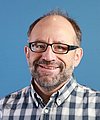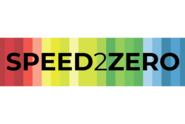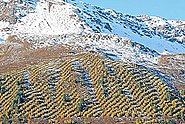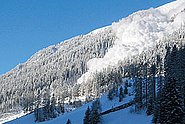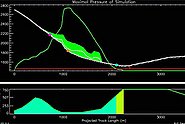
Avalanche protection ¶
Life in the Swiss Alps would be inconceivable without avalanche protection measures. Defensive structures, snow sheds, dams and forestry, closures and explosions as well as spatial planning measures protect settlements and transportation routes from avalanches. We provide expert opinions and advice on a whole variety of such protective measures.
How does a mountain village protect itself from avalanches? It's a question that has preoccupied inhabitants of the Alps since time immemorial. For centuries, our ancestors presumably built their settlements and roads on the basis of trial and error and age-old knowledge passed down over the generations. The first defensive structures were walled terraces, erected back in the 19th century. However, the increase in population density and tourism in the Alps in the 20th century demanded more reliable methods of protecting the population and their infrastructure from the threat of natural hazards such as avalanches, rockfall and mudslides. In the extreme winter of 1950/51, avalanches destroyed over a thousand buildings in Switzerland and around a hundred people lost their lives. In response, the SLF stepped up its research in the field of avalanche protection and avalanche protection measures were established in many places made of steel, aluminium, wood, wire rope or concrete.
High level of avalanche protection in Switzerland
We investigate the forces and behaviour of avalanches – an important basis for avalanche protection – and publish guidelines for the design of avalanche protection measures. Our knowledge and expertise on snow- and avalanche-related technical issues is disseminated both in Switzerland and abroad in the form of expert opinions, advice, type tests, guidelines and training courses for experts. In particularly challenging cases, we advise public bodies such as civil engineering offices and local authorities, as well as private organisations including engineering companies and railway and cableway operators, on which protective measures are best suited to specific local circumstances, and determine how economical these measures are.
In avalanche protection, a distinction is made between structural, planning, silvicultural and temporary measures. All approaches are important, but choosing and combining the right ones is the key to safety and economic viability. For financial, technical and ecological reasons, it will never be possible to offer 100% protection against avalanches. Nevertheless, Switzerland has a very high level of avalanche protection. Fortunately, fatalities in settlements or on open transportation routes are very rare nowadays.
Topics ¶
Publications ¶
WSL publications ¶
Vera Valero C., Wever N., Bühler Y., Stoffel L., Margreth S., Bartelt P. (2016) Modelling wet snow avalanche runout to assess road safety at a high-altitude mine in the central Andes. Nat. Hazards Earth Syst. Sci. 16(11), 2303-2323. https://doi.org/10.5194/nhess-16-2303-2016 Institutional Repository DORA
Volkwein A., Baumann R., Rickli C., Wendeler C. (2015) Standardization for flexible debris retention barriers. In G. Lollino, D. Giordan, G. B. Crosta, J. Corominas, R. Azzam, J. Wasowski, & N. Sciarra (Eds.), Engineering geology for society and territory - volume 2. Landslide processes. Cham: Springer. 193-196. https://doi.org/10.1007/978-3-319-09057-3_25 Institutional Repository DORA
